"Surely something is wanting in our conception of the universe. We know positive and negative electricity, north and south magnetism, and why not some extra terrestrial matter related to terrestrial matter, as the source is to the sink. ... Worlds may have formed of this stuff, with element and compounds possessing identical properties with out own, indistinguishable from them until they are brought into each other's vicinity. ... Astronomy, the oldest and most juvenile of the sciences, may still have some surprises in store. Many anti-matter be commended to its care! ... Do dreams ever come true?"
-Sir Arthur Schuster, 1898, 34 years before the discovery of antimatter
Antimatter is some of the most wonderful stuff in the Universe. All of the normal matter on Earth -- that you're used to -- is made up of atoms, which in turn are made of protons, neutrons, and electrons, like so.

But every particle that exists, whether it's a fundamental particle (like a quark, electron, or photon) or a composite particle (like a neutron or proton), also has an antiparticle!
So what is an antiparticle?
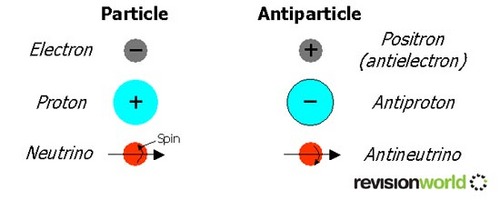
In many ways, antiparticles are the same as regular particles. Same mass, same magnitude of charge, same magnitude of spin, and if you're an unstable particle, you've got the same lifetime, too.
But there are a few very important differences! They have the opposite sign of charge, for instance. If a particle is positively charged (like a proton), its antiparticle (the antiproton) will be negatively charged. Neutrinos and antineutrinos, as another example, always have helicities (or spins, or intrinsic angular momentum, depending on your naming convention) opposite to one another. But the biggest one comes if you allow a particle to meet with its own antiparticle.
When a particle collides with its own antiparticle, they annihilate, and turn into pure energy via Einstein's famous E = mc2, typically creating two ultra-high-energy photons.
It's worth asking the question, what's truly remarkable about this antimatter?

Sure, Tom Hanks can prevent you from blowing up the Vatican with it. But as a physicist, I can tell you with 100% certainty that antimatter, for us, is the most efficient source of energy in the Universe.
Let me explain, and let me start at the beginning. When you want to do something, it takes energy.
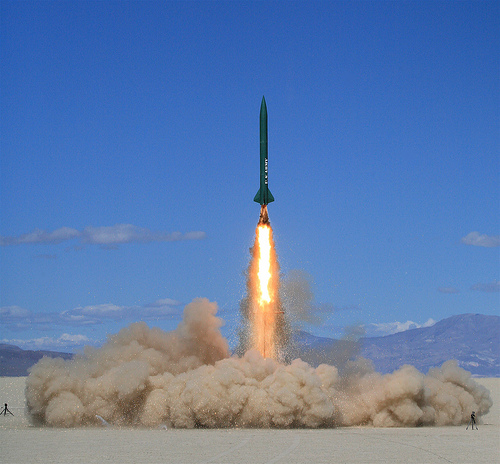
Whether you want to power a car, launch a rocket ship, or go for a walk, it takes energy to do it. Where does that energy come from? Well, regardless of whether you're a car, a rocket, or a human being, this is the source of your energy.
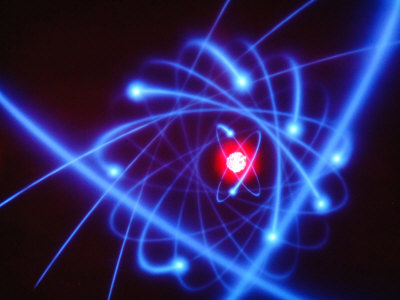
That's right, the plain old atom. The electrons orbiting your atoms store chemical energy. When the electron winds up in a lower energy configuration, it releases energy, and this is how everything from rocket fuel to TNT to the Krebs cycle to burning magnesium works: powered by atomic and molecular bonds.

Chemical energy -- the kind that works by atomic transitions -- is horrifically inefficient, however. If I bring about a million pounds of rocket fuel on board a ship, even if I have the best rocket fuel ever created, I can only turn about one pound of that fuel into energy, and I'm left with 999,999 pounds of waste. Yet, so far, this is the best we've been able to do as a fuel source, and this is currently how we power our rockets and spacecrafts.

But if we ever want to reach another star system, we're going to have to do better. You already know of a better source of energy, you need look no further than this guy.
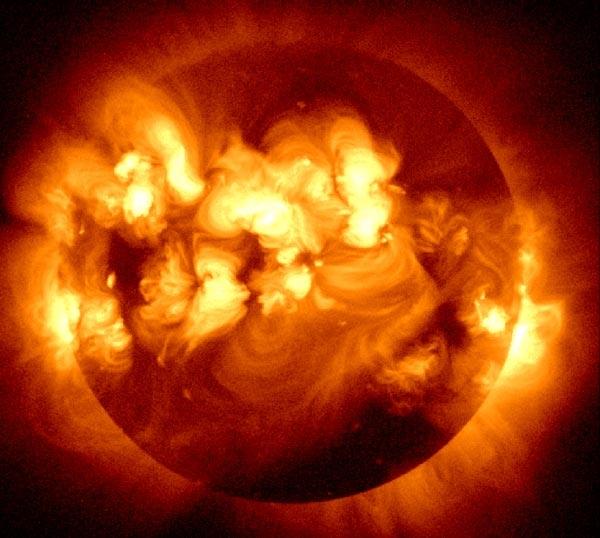
The Sun! That's right, the Sun, rather than use chemical energy, relies on nuclear energy! Nuclear fusion, which fuses lighter elements into heavier ones (like the Sun), and nuclear fission, which splits apart heavy, unstable elements into lighter, more stable ones (like nuclear bombs or power plants), both are far more efficient than any form of atomic energy.
How much more efficient? If I had a million pounds of hydrogen, and I fused the entire million pounds into helium, how much would turn into energy, and how much would turn into (helium) waste? I'd get about 7,000 pounds worth of energy (which, by E=mc2, is a lot, but I'd still get 993,000 pounds of waste. 0.7% efficiency isn't so great, all things considered.
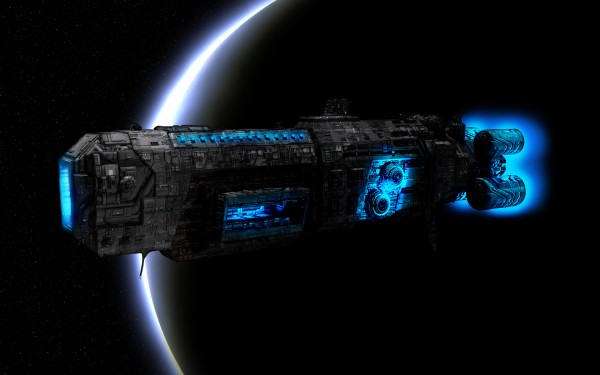
But that's where antimatter comes in. When we dream of interstellar spaceflight, we dream of a perfect fuel source. And if I brought a million pounds of fuel on board -- 500,000 pounds of hydrogen and 500,000 pounds of antihydrogen -- I'd get perfect efficiency: 1,000,000 pounds worth of energy and no waste.
(Yes, it takes much, much more than a million pounds of energy to make 500,000 pounds of antihydrogen, but that's not the point.)
And that's why creating and trapping neutral anti-hydrogen is such a big deal!
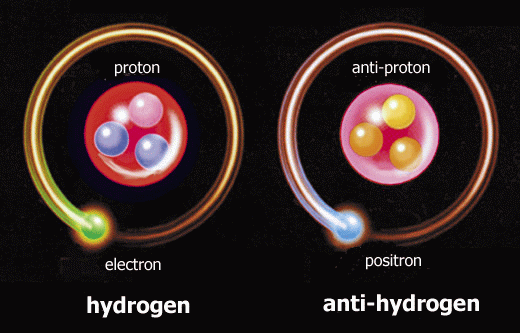
Sure, we're a long way away from making half-a-million pounds of it, but this is the lightest, most stable form of antimatter we can make. And in principle, we can store an arbitrarily large amount of it for as long as we want.
This, no doubt, is the fuel of the long-term future. And while it's way too early to start thinking about large, practical amounts of it anytime soon, this is the start of something that's sure to be very, very big!
So if someone asks you what the big deal about antimatter is, you know what to tell them. Most. Efficient. Fuel source. Ever. In principle. And we just successfully stored it for the first time. So don't be afraid to dream big; I know it's what I'll be doing!

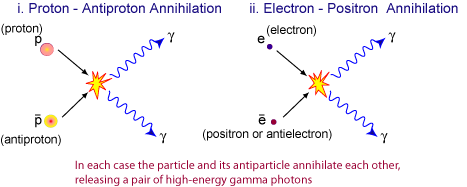
Yes, antimatter is the most efficient source of EM energy, but how do we convert all those gamma photons into a practical rocket propulsion system?
Dopey question: Could you make semi-anti deuterium with a proton and an anti-neutron for a nucleus?
If so, that seems like an easy way to store antimatter.
...But theyre gonna let it go, right? Theyre not going to trap/store it forever... right???
:( Poor little antihydrogen :(
The plasma conduits will be difficult though.
It's odd when you think about it. Star Trek was so accurate in some of its predictions.
...that should be chemical energy.
I'd claim that the main reason why making antihydrogen may be of interest in our lifetimes is for fundamental physics tests of invariance under various symmetries. Chad Orzel has a nice post about this.
I like antimatter for science-fiction spaceflight, but was taken aback by the statement that
"we can store an arbitrarily large amount of it for as long as we want." Is this really a solved problem? How do we do that?
...And when we can manufacture anti-neutrons in sufficient quantity, we should pack them into long needles of anti-neutronium, sending them throughout the galaxy to seek planets that have developed intelligent life, then bombing their planet cores in a timed anti-matter reaction that will rearrange the crust and wipe out all inhabitants in order to clear out potential competition and prepare the star systems for eventual colonization.
I read this in a book somewhere.
Generally a larger amount of normal matter than antimatter would be used, at least for fuel purposes, with the rest of the matter absorbing the gamma radiation and converting it into kinetic energy, becoming reaction mass. So a little waste is good, at least for antimatter rocket purposes.
Everybody forgets about the fly in the ointment when it comes to interstellar flight : dust. And larger objects too, of course, but the faster you go the worse your problems of impact energy from collisions will be - and you'll hit more objects too.
If you want to talk about fuel efficiancy, isn't not carrying your fuel even better?
Solar sails and big lasers, oooooh yea. :)
And how would you create that 1 million pounds antimatter? All we have is chemical energy. At a realistic 1% conversion rate would have to use one hundred million million pounds of the most efficient rocket fuel available. Or, alternatively, try burning half the world's oil reserves.
And this for what? To fly to the nearest star? That would take 100 years, during which time the travellers would be exposed to intense radiation, which would fry the traveller's brain in 10 days.
@qed, most science fiction that mentions antimatter generation has it take place in facilities considerably closer to the local star - very large arrays of solar panels providing them with the electrical energy they need.
It's still not terribly efficient, but better than using chemical energy.
I'm neither a physicist or a sci-fi writer, though, so don't quote me on that. :-)
If we have to make the antimatter ourselves, doesn't it make more sense to think of it as an energy storage medium rather than as an energy source? We're still limited by the efficiency of the least efficient step in producing the antimatter; it's just (hypothetically) easier to carry around a little antimatter than an equivalent amount of gasoline.
It rather is the point, if you're going to throw around terms like "energy source." It's not an energy source, it's an energy storage medium, and if you want to talk about the efficiency of an energy storage medium, you need to consider the "charge" efficiency as well as the "discharge" efficiency.
Let's not let our enthusiasm for sci-fi fantasies overwhelm our understanding of physics.
Charge efficiency is important, yes. The outrageous energy requirements needed to generate bulk quantities of antimatter are why no planetary energy economy will ever be based on total conversion. But travel -- especially interstellar travel -- is different. When attempting to accelerate your vessel to the speeds necessary to make interstellar travel even a little feasible, the energy density of your fuel is paramount.
In that context, the charge efficiency really doesn't matter. But let's be honest, anyway. Any society seriously considering generating a half-million pounds of neutral antimatter to use as a propulsion source is not doing it using our laboratory-scale generation methods; rather, they are harnessing a non-trivial fraction of their star's solar output (via Dyson bubble or equivalent statite network).
This is an excellent article. I have one minor, semantic gripe viz. the use of the word efficiency. You're quite correct in stating that half a million pounds of hydrogen would annihilate with half a million pounds of anti-hydrogen to produce the equivalent of a million pounds of energy. However we would not be able to utilise all of it. It's a fundamental thermodynamic principle that no process can convert all of a system's energy into work. The efficiency of an engine is defined as the ratio of work done to heat energy put in. The idealised perfect engine, the Carnot engine, is the most efficient theoretical one. Yet it's efficiency is always less than one. Some of the photons produced in annihilation will heat the engine and not produce work. In this sense this process in not perfectly efficient. That said, the total energy liberated is so great in comparison to chemical and nuclear processes that even a mildly efficient engine would produce vast amounts of work.
"Most. Efficient. Fuel source. Ever. In principle."
Is it safe to say that? First, we don't know what exactly Gravity is. Second, we don't know what exactly Time is.
Why do you need to transform matter into energy to receive energy? Can't you transform gravity or time into energy? Or energy of one type into energy of other type? Or gravity into time or time into matter etc.
One of my much earlier read science fiction authors such as Heinlein or Azimov wrote in one of his stories that energy is everywhere but that our chief task is to be able to transport it to actually use as needed. The protagonist of the story became very rich because he had invented a means to store and thus utilize a great supply of energy within a very small portable device or container which of course became the worldwide standard for energy use. The inventor did not bother to patent this device because it could not be opened for reverse engineering without it completely destroying itself. Antimatter, perhaps?
Blended scope of the day: What we observe as gravity might appear to be the multidimensional storage of mass which is the difference between pure energy and substantial matter. We might end up like Spider man having to realize that "with great power comes great responsibility".
http://en.wikipedia.org/wiki/Spider-Man:_Shattered_Dimensions
@ ixat.art :
the "Forge of God" i believe.
I believe the work you are referring to is Friday by Heinlein, and the devices were called "Shipstones." They provided massive to functionally infinite energy storage in a scaleable package (in that particular universe people used tiny forms of the devices to power hand tools and flashlights, and giant forms of the devices to store power for insterstellar starships).
It's been some years since I've read it, but as I recall you're correct about the patenting. The inventor had opted to keep the manufacturing process secret rather than patenting it, and it could not be reverse engineered, so he maintained an absolute monopoly.
There was also an interesting aside about the "Shipstone corporation" "turning the entire Sahara into a solar energy farm" to generate power to fill the devices.
No. There is always waste. If you are combining protons and antiprotons then you will be getting more than just gamma radiation. You will also be producing neutrinos and antineutrinos. Those won't be interacting with your reaction mass, so they will spirit away energy.
It's still a very energy rich fuel though. This old NASA paper estimates that a 6 month trip to Mars and back would require 582 mg of antihydrogen: http://gltrs.grc.nasa.gov/reports/1996/TM-107030.pdf
wait, what?
I was under the impression that it was devilishly hard to contain actual anti-matter atoms because they would just bounce into the walls of whatever vessel they were in and annihilate. I had understood that this was why it was so difficult to create antimatter atoms in the first place, and why most antimatter is actually stored as antiprotons in magnetic containment fields.
What most of you are missing in regards to using chemical energy to create the anti-matter is once u have a small amount of the antimatter, you can then use that to energy to make more. This way you don't need to use a great deal of chemical energy. Just a small amount until you can begin using the anti matter to supply your energy needs.
What I do not understand is how are you going to efficiently make so much of antimatter? Isn't making anti-matter extremely inefficient? The net energy gain is negative.
Just curious :D
What do you think that is gonna cost? I mean, making that 582mg.. or, say 100mg of Antimatter?
It takes at least as much energy to produce antimatter as you get from annihilating it, so...
Given that you're just converting mass, and that 50% of the mass is normal matter, this would only work if your energy -> antimatter process has an efficiency of better than 50%.
If I understand Wikipedia's article on pair production correctly, producing antimatter requires energy equivalent to the mass of the antimatter and an equivalent amount of normal matter, so even at 100% efficiency you're just breaking even.
Rereading my last post, it's not as clear as it could be. It should be parsed as "...producing antimatter requires energy equivalent to (the mass of the antimatter and an equivalent amount of normal matter)..."
The matter-antimatter reaction may produce a lot of energy, but how much of that is in a useful form? I certainly don't recommend gamma irradiation as a means to heat something.
Is there any ongoing research to enhance the production of antiparticles?
Why is there no anti-light, just photons traveling in opposite directions?
A couple of questions:
1) The second diagram shows a neutrino and an antineutrino spinning in opposite directions; shouldn't their angular momentum vectors be antiparallel?
B) You've written that a particle will annihilite with its anti-self. What if a proton and, say, a positron collide? What would happen? How much energy/mass would be converted? What would be produced?
This site is great. The protagonist of the story became very rich because he had invented a means to store and thus utilize a great supply of energy within a very small portable device or container which of course became the worldwide standard for energy use.
Crux Australis;
Erm, I think this describes a perpetual motion machine. Your maximum net energy gain will never be more than the energy introduced from the initial chemical source.
Oz > Can't you transform gravity or time into energy?
Only if you have enough time. But nobody does...
crd2 > .... then use that to energy to make more.
US patent office no longer accepts applications describing perpetuum mobile...
Joe Steeve,
The energy content (m*c^2) of 600 mg of anti-matter plus 600 mg of normal matter is about 10^21 erg, or 30 million kilowatt hours. At $0.10 per kilowatt hour, that's $3 million worth of energy. Unfortunately, that doesn't count the enormous facility that would be required to actually make that much anti-matter, nor does it account for a miserable conversion efficiency. The CERN collaboration made about a tenth of an erg worth of anti-hydrogen.
Another big problem with anti-matter is, as others have mentioned, confinement. The CERN collaboration used a magnetic trap (neutral atoms and anti-atoms do have a magnetic moment), but even very cold anti-matter diffused out in a couple hundred milliseconds. Storage and transport would be difficult indeed, and imagine the chaos you would get in an accident.
My problem with your notions is that they are notions, i.e., ideas that lack material connections.
Matter and anti-matter annihilate each other.
We create anti-matter by using particles of our present material universe, lasers or accelerators, and bashing them against each other at certain energy levels.
This usually produces both matter and anti-matter particles which demonstrates that the universe we live in is itself the product of anti-matter and matter.
If indeed we are the product of the two is it not possible that the search for "missing" anti-matter is itself the product of a quixotic mental aberration wherein we invent what may be subjectively desirable but is long gone the process producing it having ceased, in most areas of the universe, as things cooled down after the big bang.
What I am suggesting is that this matter - anti-matter concept (As far as it being a stable material) is much the same as the quest for a god of some sort. It is much the same as the notion that many of the sub-atomic particles we produce with giant accelerators have any more existence save as fleeting moments in our reproduction of the process' present at big bang.
The new space telescope about to be launched which will see light much further back to the time of big bang and viewing images of that earlier universal high energy state may indeed see particles of anti-matter but we should also learn from that experience that parts of what existed then, and which we are capable of momentarily recreating in our laboratories, have in the main been subsumed into the matter of our present universe, except perhaps for occasional high energy spots created by stellar collisions or explosions.
I am not a physicist nor a mathematician but rather someone who is interested in physics and pays close attention to it. As a result I pay close attention to the thinking process beneath.
Thus it seems to me that like the notion of "the end of history" the seekers for ongoing anti-matter seek to vanish in mind the present reality of a continuously moving and developing material reality of which, in terms of energy levels the time of anti-matter is the distant past.
We may find out when as a result of the new telescope we are able to see the light image of that past.
Jack Jersawitz
bigjackjj@yahoo.com
(NY Times you may publish contact info.)
I doubt it, since both neutrons and protons consist of up and down quarks. If my maths is right, it'll be something like: anti-n(anti-udd) + p(uud) -> 2 γ + (u anti-d), which I guess is a meson of some sort.
Anti-deuterons are created in high energy particle collisions. They are nuclei formed of an anti-proton and anti-neutron. They were first observed in 1965. Their rate of production is much smaller than for anti-protons or anti-neutrons alone. As far as I know there has not been a successful experiment to capture them and form anti-deuterium (ie with a positron). Other known anti-nuclei are anti-triton (anti-p, 2anti-n) and anti-He3 (2anti-p, anti-n) and the recently discovered anti-hyper triton (see http://sciencemag.org/cgi/content/abstract/science.1183980)
I do not see the advantage of using these heavier anti-nuclei for the energy storage applications mentioned here.
All quantum processes are 100% efficient, i.e. there is no friction. Hence, the emission of photons by a hydrogen atom dropping to a lower energy state is 100% energy efficient. Thus the conversion of antimatter into matter (usually referred to as antimatter/matter annihilation) is no more efficient in producing photons (still only 100% efficiency); though it does produce higher energy photons (i.e. gamma rays).
Now the problem with this 100% efficiency of quantum mechanics is scaling up to classical size; hence, whether in a light bulb or the sun, inefficiencies emerge in the scaling to classical physics. Likewise, inefficiencies will emerge in the scaling up of matter/antimatter production of gamma rays to the classical realm.
Nevertheless, the production of a large quantity of antimatter (e.g. .001 ml) that is stable for a significant period of time (e.g. 1 minute) would be an amazing achievement in itself; and it would allow for further amazing new fundamental physics experiments.
Proper understanding of antimatter is essential to develop a deeper understanding of gravity, time, extradimensions, and other fundamental physics.
Antimatter as Wheeler and Feynman noted is simply matter moving backwards in time. This is not just a pragmatic idea to simplify QED calculations; it is a fundamental property of matter and antimatter.
Matter carries a time-forward charge and antimatter carries a time-backward charge. At the level of an elementary particle or even an atom there is no such thing as classical phenomenological time, that is an emergent phenomenon.
Moving matter generates a time-forward field and antimatter a time-backward field. This is similar to a moving negative electric charge generating a field in the opposite direction of a moving positive electric charge. But in matter versus antimatter we are not talking about electric-charge; but time-charge.
Thus antimatter (as seen in our visible forward-time subuniverse) is simply matter that is moving backwards in time (relative to us). Thus a positron (an electron moving backwards in time, relative to us) has electric charge and spin the reverse of an electron (reverse relative to us).
But what about the gravitational and inertial mass of an antiparticle? Well if particles gravitationally attract in their time-forward gravitational field; then antiparticles will gravitationally repell in their time-reverse gravitational field (as seen from our time-forward point of view). Further matter should neither gravitationally repell nor attract antimatter, i.e. their relation is temporally neutral. Further, inertial mass is a scalar independent of the time-charge of a particle, i.e. a particle and its antiparticle have identical inertial mass. Finally, antimatter is unstable in our matter subuniverse; it will temporally rotate to become matter or spatially rotate into an extradimension.
Thus between our time-forward subuniverse (a.k.a. our visible universe) and the time-backward antimatter subuniverse, there is conservation of time-charge. This is no different than conservation of electric-charge; except perhaps that there may be more quanta of time than + and -; but that is a longer discussion.
The point is that without a significant quantity of antimatter; its time-charge property and gravitation mass and inertial mass characteristic and extra-spatial-dimension implications of antimatter can not be tested.
Basically the temporal field is a 1 dimensional moebius field that goes from +0 > +oo > -0 > -oo > +0, etc.. And conservation of time causes a bifurcation of space into 3 spatial matter dimensions (our visible universe) and 3-spatial-antimatter dimensions. Our matter subuniverse and an antimatter subuniverse are orthogonal, curled up, and relative to one another in a Calabi-Yau sense. The other single dimensions are quantum vacuum dimensions associated with delta times of + or - 0 or oo.
Finally, I should note that an antimatter time-reverse subuniverse (e.g. a subuniverse in which every particle in our visible universe is replaced with a mirror image antiparticle) will behave exactly like our visible universe and inhabitants of such an antimatter subuniverse would be unable to determine if they existed in a matter or an antimatter subuniverse. In other word the direction of time is a relative direction like up and down; just as it is arbitrary to say the northern hemisphere is spatially up and the southern hemisphere is spatially down. Thus the dierction of time (forward or backward) is a quite arbitrary quantum concept that has no fundamental quantum meaning despite the usefulness of the local classical phenomenological concept for sequencing classical events.
I'll echo Matt @#5 and add that "atomic transitions" could perhaps better be expressed as "electron transitions".
We do have the potential to right now develop positron rocket propulsion. Maybe not as good as anti-proton propulsion but positrons can be stored almost as readily as electrons but not so with anti-protons. This makes positron propulsion possibilities real using present technologies.
I believe the problem with anti-protons, contrary to the standard model, is that they are short-lived particles something like free neutrons (about 15 minutes). When in an accelerator that could re-enforce their spin adding to their longevity. Cryogenic storage also increases their half life as it does free neutrons.
My guess is that a properly designed coil shaped cyclotron (like a spring bent into a circle) with an additional cryogenic system might someday increase their storage life long enough to be used for interplanetary or interstellar travel. In the meantime let's keep trying but what's wrong with positron propulsion. The gamma rays produced by both systems could also be a power source for an secondary in-line chemical propulsion system conceivably resulting in no harmful exhausts.
If antimatter would annihilate matter in order to produce energy, I think time would come that we would face scarcity of matter.
isn't anti matter extremly unstable? Wouldn't it create a possibly cataclysmic disaster? How would we keep it stable?
Really amazing. I really never had dreamt about. Thanks for providing brief but precious knowledge about antimatter.
What if ant-matter is easy to create but as soon as it appears it is reversed to matter. I keep thinking about the Fleishman-Pons experiment that the experimenters were absolutely sure happened but could not be reproduced?
No danger, just ephemeral existence.
So, we're back to using most of our energy to 'see' something that has no actual use time.
Have you heard of this energy researcher called mehran keshe who is a nuclear engineer who has developed a plasma reactor which can provide antigravity lift. He claims he has a prototype that has achieved lift. Website is http://www.keshefoundation.com/en/ , http://www.keshefoundation.com/en/applications/transportation , http://www.keshefoundation.com/en/applications/space . Patent is http://www.freepatentsonline.com/EP1770717.pdf . this is a presentation by keshe at Eindhoven. Website is http://www.youtube.com/watch?v=fCFO3-MOCYE . He claims his craft will be seen as lights in the sky. What do you think of his work? He claims it is a kind of plasma fusion. He is planning to set up an online space institute here http://keshefoundation.com/en/institute . Registration is free. He will be teaching about his technology and providing four free PDF e books based on his patents. What do you think of his work? On September 21st he will release all info on his technology to the worlds scientific community here http://www.keshefoundation.org/en/institute
I thought you might like to know. Do you think he could be for real? He claims his technology would allow for faster than light travel which could lead to time travel. Also he claims force field protection from radiation and meteors like in Star Trek. He claims to be using antimatter and dark matter.
Soler energy is very important source of Non-conventional energy resource in our Earth.If we use soler energy properly and than no lack of fuel in Earth.
HELLO, I WANT TO KNOW IS THERE ANY PHYSICAL EXISTANCE OF ANTIMATTER ? IS IT CREATED BY HUMAN?IF YES , HOW?
can you tell why we get only 0.7% of efficiency in converting matter to energy?
why only 24% with a care engine?
As you need opposite charges for attraction force
how you manage to orbit a positron(+) around a proton(+)?
Positron will fly away :)
From: Sam Paris
November 22, 2010
Dopey question: Could you make semi-anti deuterium with a proton and an anti-neutron for a nucleus?
If so, that seems like an easy way to store antimatter.
sorry, just misunderstood.
You try to create a nucleus with two components, a proton and an anti-neutron.
i think it heavily depends on subatomic particles.
From: Sam Paris
November 22, 2010
Dopey question: Could you make semi-anti deuterium with a proton and an anti-neutron for a nucleus?
If so, that seems like an easy way to store antimatter.
Lets do the budget and how unsafe antimatter is:
antimatter is the most expensive material to make.In 2006, Gerald Smith estimated $250 million could produce 10 milligrams of positrons (equivalent to $25 billion per gram). 1999, the antimatter price for NASA is approximently $62.5 trillion per gram of antihydrogen. See how expensive that is.
Worst the world is in a economic situation.
The destruction:
Antimatter is no doubt, the most destructive material mankind will ever possess. Even more destructive than nuclear or hydrogen bombs. Half a gram can be a hiroshima blast: imagine a pound of antimatter, the earth would no longer exist... Look it how careless it went for nuclear power and material, antimatter, what if it gets stolen, well...i don't know....
I also wonder if its possible to get antimatter naturaly by a magnetic scoops over, thunderstorms, van allen belt, or even the gas planet jupiter, i think antimatter is too dangerous and costly to produce.
Also making antimatter into rocket fuel is not easy, any mishandling or leakes mean BOOM!, i think is a great way to start the future but, its dangerous, yes i said it a million times. When nuclear energy was invented, everyone was thinking about the bright future of a continuious, enviromental, and safe energy source, very few knowed about its potentials of man killing capacity (nuclear bombs and radiation, dirty bombs, etc). When the nuclear arms race started, both sides (russia and us mainly, maybe china as well on the soviet side) began the arm race, and at the end, soviet government and as some other government around the world got careless about the nuclear things (nuclear compounds and bombs) or they went into a economic crisis. Now back to the antimatter story, what if it gets stolen or used as a doomsday weapon? Most people would say "what if we put it in a bunker, secret facility, etc", well there are possibilities and it will happen one day when some cult or terrorist or Mr. Physco nuclear scientist:) takes it or steal it. Old soviet russia was a great example how nuclear power and materials went off hand because of poor security and economic problems and rival countries (India and Pakistan example) make their own nuclear race, anyone have an idea how to secure the "most expensive and dagerous material in the world" because like the old saying, saftey and security is first when making and dealing with this stuff (especially antimatter).
@ Erik
you've been reading too much Dan Brown....
well, as per theoretical estimates, an anti-matter + matter propelled rocket can actually hit 50-80% light speed as per project ORION s documentation, for those of you who are not sure, Google project orion
> But as a physicist, I can tell you with 100% certainty that antimatter, for us, is the most efficient source of energy in the Universe.
Um, no. It will never be a "source" of energy, because there is no source of it that doesn't require energy input.
But it certainly is the most efficient form of energy storage, yes.
#coolfuion checkout http://www.coolfuion.com for some really cool antimatter technology
Nah, it's going to be a bullshit site.
It can't even spell correctly.
antimatter is so expensive then how we will make it. it costs about 62.5 trillion doller why? any reason it so expensive....!!:)
What's going on now with antimatter is akin to Ford's Model T, efficiencies will increase and progress made as long as an interest can be maintained. Tidal power hasn't even been mentioned as a source for conversion, yet that's pretty consistent.
Also relevant in an improved efficiency in Gamma shielding, as you have not only that produced in the reaction, but we're learning to bend space now as well which in theory can take velocity well past c. This will push the visible approaching light into to Gamma range via Doppler shift, so that's a lot of radiation at you.
Sources -
Journal of Physics Special Topics
P1_3 Relativistic Optics
Argyle J, Connors R, Dexter K, Scoular C
Department of Physics and Astronomy, University of Leicester, Leicester, LE1 7RH.
October 31, 2012
http://io9.com/5963263/how-nasa-will-build-its-very-first-warp-drive
John, please don't buy in to any wild claim just because they sound "cool".
And don't make ones up because you think they could be "cooler" if true.
Lastly, if you're going to put a load of unrelated things together, do try to make them clear as to what they are for. Nobody needs to know the address of Leics U and what NASA is being claimed to be doing (they do a lot of dumb shit in their skunkworks, because sometimes there could be something interesting going on). They don't fit together AT ALL.
If we use 1 million pounds of energy to make 500,000 pounds of antihydrogen then that process would only need to be completed once due to the fact that the antihydrogen could fuel the creation of the new antihydrogen and it would be more efficient that way.
This article just reminds me of Maggi: the labyrinth of magic..